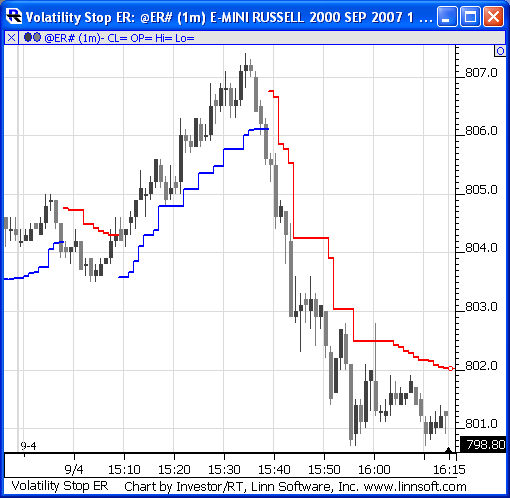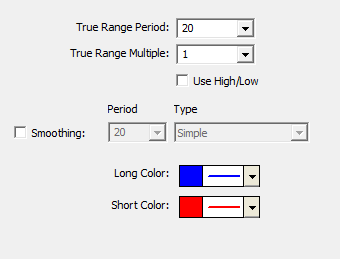Please note that the VSTOP indicator is similar to the original "ATR Stop" indicator (still present in the overall indicator list), but it includes 2 additional features: a smoothing capability and the ability to consider the high and low of the bar (instead of the Close)
The Volatility Stop Indicator helps define the current trend. The indicator plots a red line above the price bars when a downward trend is detected, and a blue line below the bars when an upward trend is detected. These lines are commonly used as trailing stops. This indicator is commonly used as an exit tool rather than an entry technique. When the price crosses the VSTOP value, the trend reverses, and VSTOP moves to the other side of the price. The VSTOP calculation method can be found above.
Short to Long Reversal bar: CL > VSTOP AND CL.1 <= VSTOP
Long to Short Reversal bar: CL < VSTOP AND CL.1 >= VSTOP
The Formula
- When Up Trend Detected.... VSTOP = CL - MULT * TR
- As Up Trend Continues.... VSTOP = MAX(VSTOP.1, MaxCL - MULT * TR)
- When Down Trend Detected.... VSTOP = CL + MULT * TR
- As Down Trend Continues.... VSTOP = MIN(VSTOP.1, MinCL + MULT * TR)
Where
- CL = Closing Price
- MULT = True Range Multiplier
- TR = True Range
- VSTOP.1 = Volatility Stop Value on Previous Bar
- MaxCL = Maximum Closing Price since Up Trend Began
- MinCL = Minimum Closing Price since Down Trend Began
Trend reverses between up and down when Closing Price crosses VSTOP.
Presentation

Above is a 1-minute of the Russell Mini Contract (@ER#, DTN IQFeed). The Volatility Stop Indicator is plotted overlaying the candlesticks. The blue line represents areas where an upward trend is detected. Red line represents areas where a downward trend is detected. The preferences seen below were used in this instance.


